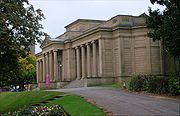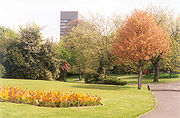
Sheffield City Museum
Encyclopedia



Sheffield
Sheffield is a city and metropolitan borough of South Yorkshire, England. Its name derives from the River Sheaf, which runs through the city. Historically a part of the West Riding of Yorkshire, and with some of its southern suburbs annexed from Derbyshire, the city has grown from its largely...
, England
England
England is a country that is part of the United Kingdom. It shares land borders with Scotland to the north and Wales to the west; the Irish Sea is to the north west, the Celtic Sea to the south west, with the North Sea to the east and the English Channel to the south separating it from continental...
, lies beside Weston Park
Weston Park, Sheffield
Weston Park is a public park with an area of just over 5 hectares in the City of Sheffield, South Yorkshire, England. It lies immediately west of the City Centre. It is situated next to the University of Sheffield Library, Geography and Firth Court buildings, and across the road from Sheffield...
and surrounded by the University of Sheffield
University of Sheffield
The University of Sheffield is a research university based in the city of Sheffield in South Yorkshire, England. It is one of the original 'red brick' universities and is a member of the Russell Group of leading research intensive universities...
. It is managed by Museums Sheffield.
The building, neo-Classical
Neoclassical architecture
Neoclassical architecture was an architectural style produced by the neoclassical movement that began in the mid-18th century, manifested both in its details as a reaction against the Rococo style of naturalistic ornament, and in its architectural formulas as an outgrowth of some classicizing...
and in the Ionic order
Ionic order
The Ionic order forms one of the three orders or organizational systems of classical architecture, the other two canonic orders being the Doric and the Corinthian...
, was completed in 1868, and extended twice since. Some of the extension works were funded by donations from local businessman J. G. Graves
John George Graves
John George Graves was a successful English entrepreneur and public benefactor. He became Sheffield's Lord Mayor and an Alderman in 1926 and he was given Freedom of the City in 1929. He was born in Lincolnshire in 1866 and died in 1945, after having settled in Sheffield.Graves moved to Sheffield...
. The front part of the building was the city museum
Museum
A museum is an institution that cares for a collection of artifacts and other objects of scientific, artistic, cultural, or historical importance and makes them available for public viewing through exhibits that may be permanent or temporary. Most large museums are located in major cities...
, while the rear was the art gallery
Art gallery
An art gallery or art museum is a building or space for the exhibition of art, usually visual art.Museums can be public or private, but what distinguishes a museum is the ownership of a collection...
. The art gallery is a Grade II* listed building.
Weston Park Museum was named the Sheffield City Museum and Mappin Art Gallery until 2006. It opened in 1875, and housed Sheffield's archaeology
Archaeology
Archaeology, or archeology , is the study of human society, primarily through the recovery and analysis of the material culture and environmental data that they have left behind, which includes artifacts, architecture, biofacts and cultural landscapes...
, natural history
Natural history
Natural history is the scientific research of plants or animals, leaning more towards observational rather than experimental methods of study, and encompasses more research published in magazines than in academic journals. Grouped among the natural sciences, natural history is the systematic study...
, decorative art
Decorative art
The decorative arts is traditionally a term for the design and manufacture of functional objects. It includes interior design, but not usually architecture. The decorative arts are often categorized in opposition to the "fine arts", namely, painting, drawing, photography, and large-scale...
and social history
Social history
Social history, often called the new social history, is a branch of History that includes history of ordinary people and their strategies of coping with life. In its "golden age" it was a major growth field in the 1960s and 1970s among scholars, and still is well represented in history departments...
collections.
The Mappin Art Gallery had a small section given over to a rotating exhibition
Art exhibition
Art exhibitions are traditionally the space in which art objects meet an audience. The exhibit is universally understood to be for some temporary period unless, as is rarely true, it is stated to be a "permanent exhibition". In American English, they may be called "exhibit", "exposition" or...
of the city's collection, but the majority of its galleries contained a contemporary mixture of commissions and touring exhibitions.
The building closed in March 2003 for complete renovation. The £17.3 million re-development was partly funded by the Heritage Lottery Fund
Heritage Lottery Fund
The Heritage Lottery Fund is a fund established in the United Kingdom under the National Lottery etc. Act 1993. The Fund opened for applications in 1994. It uses money raised through the National Lottery to transform and sustain the UK’s heritage...
, Sheffield City Council
Sheffield City Council
Sheffield City Council is the city council for the metropolitan borough of Sheffield in South Yorkshire, England. It consists of 84 councillors, elected to represent 28 wards, each with three councillors...
and Objective 1 for South Yorkshire. The building reopened in October 2006 as Weston Park Museum.
There are seven galleries: the Harold Cantor Gallery, Sheffield Life and Times, History Lab, Arctic World, What on Earth!, Treasures and About Art. The Harold Cantor Gallery houses temporary exhibitions, which can change up to four times a year. There is also a weather station monitoring area in the foyer.
The museum has been updated to appeal to families and non-traditional museum visitors as well as the seasoned museum visitor, and won The Guardian
The Guardian
The Guardian, formerly known as The Manchester Guardian , is a British national daily newspaper in the Berliner format...
s
Family Friendly Museums award in 2008.
Entrance is free and the museum is open every day.
The museum's archaeology exhibits include a replica of the Bronze Age
Bronze Age
The Bronze Age is a period characterized by the use of copper and its alloy bronze as the chief hard materials in the manufacture of some implements and weapons. Chronologically, it stands between the Stone Age and Iron Age...
rock art from Gardom's Edge
Gardom's Edge
Gardom's Edge is located near Baslow in Derbyshire, England.The shelf between Gardom's Edge and Birchen Edge is now moorland used for grazing sheep, but was inhabited and arably farmed duringthe Bronze Age...
and many items collected by Thomas Bateman
Thomas Bateman
Thomas Bateman was an English antiquary and barrow-digger.-Biography:Thomas Bateman was born in Rowsley, Derbyshire, England, the son of the amateur archaeologist William Bateman...
, notably the Benty Grange helmet
Benty Grange helmet
The Benty Grange helmet is an archaeological artefact excavated by Thomas Bateman in 1848 from an Anglo-Saxon tumulus at the Benty Grange Farm in the civil parish of Monyash in the English county of Derbyshire....
which closely matches the descriptions of warriors' helmets in Beowulf
Beowulf
Beowulf , but modern scholars agree in naming it after the hero whose life is its subject." of an Old English heroic epic poem consisting of 3182 alliterative long lines, set in Scandinavia, commonly cited as one of the most important works of Anglo-Saxon literature.It survives in a single...
.

